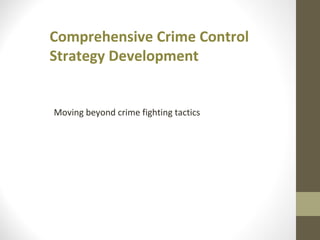
Crime Control Strategy Development
- 1. Comprehensive Crime Control Strategy Development Moving beyond crime fighting tactics
- 2. Crime Control Strategy Few police departments use a crime control strategy development process or methodology. Most departments develop and deploy anticrime tactics. These are usually resource specific, one dimensional tactics designed to counter a specific crime type for a specific period of time in a specific geographic area. A comprehensive crime control strategy encompasses a number of tactics across the entire criminal justice spectrum that are designed to disrupt specific crime types from several angles over a long period of time. The benefit of a successful strategy as compared to a successful tactic, is a strategy targets the crime in such a way as to permanently deny criminals the opportunity to commit the specific crime.
- 3. Elements of a Crime Control Strategy Process • Risk Assessment • Analyze the target crime • Gain an understanding of engagement points within the criminal justice system; from before a crime occurs through offender re-entry • Develop crime-specific tactics for engagement points • Develop a strategic communications plan in support of the strategy • Identify opportunities to leverage technology in support of specific tactics and the overall strategy • Identify performance measurement objects for the strategy and measure against those objectives on a set period; i.e. integrate into COMPSTAT
- 4. Risk Assessment Risk assessment helps police departments to prioritize their effort, maximize resource utilization and to understand the at-risk populations within their community •Assessment of crime: prevalence of crime by crime type; determine target crimes based on community expecations •Assessment of vulnerabilities as they relate to the target crimes • Vulnerable populations • Vulnerable locations
- 5. Analysis of the target crime • Determine specific aspects of the crime type where you can focus your tactics; i.e. burglary requires a location, robbery requires a personal interaction between victim and perpetrator, vehicle burglary requires a vehicle. • Determine perpetrator profiles for each crime type – Who are the people committing the crime? Know your criminal! • Are they criminals of opportunity, or organized criminal enterprises?
- 6. Criminal Justice Engagement Points
- 7. Offender re-entry program • Forensic Evidence & Crime Scene Processing • Intelligence-Led Policing • Proactive policing teams • Intelligence support for operations • Property Marking • Looking Beyond the Plate • Data-Driven Approaches to Crime and Traffic Safety (DDACTS) Develop crime-specific tactics for engagement points • Justice Advocate Program Pre-crime Arrest Prosecution Corrections Re-entry
- 8. Offender re-entry program • Forensic Evidence & Crime Scene Processing • Intelligence-Led Policing • Proactive policing teams • Intelligence support for operations • Property Marking • Looking Beyond the Plate • Data-Driven Approaches to Crime and Traffic Safety (DDACTS) Develop a strategic communications plan • Justice Advocate Program Pre-crime Arrest Prosecution Corrections Re-entry Strategic Communications
- 9. Technology Offender re-entry program • Forensic Evidence & Crime Scene Processing • Intelligence-Led Policing • Proactive policing teams • Intelligence support for operations • Property Marking • Looking Beyond the Plate • Data-Driven Approaches to Crime and Traffic Safety (DDACTS) Identify opportunities to leverage technology • Justice Advocate Program Pre-crime Arrest Prosecution Corrections Re-entry Strategic Communications
- 10. Identify performance measurement objects • Use a system of comparative performance measurement, such as COMPSTAT, to measure effectiveness of the strategy on a periodic basis • Modify the strategy as necessary to incorporate new tactics or technologies
- 11. Make it comprehensive and the results with be significant and sustained! Physical Security Crime Prevention Offender Tracking Public Education Proactive Policing Problem-solving Policing
